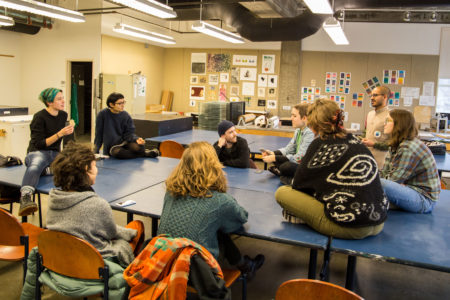By: Zane Silk ’20
The new art SEPC hopes to foster a strong artistic community at Grinnell, stretching beyond the art majors to all students interested in art. Before fall 2016 the art and art history SEPC split into two groups, so the Studio Art Department’s SEPC has been able to focus its attention on student-made art. With that in mind it is planning two shows of student artwork this semester. The art SEPC consists of Hazel Batrezchavez ’17, Joshua Anthony ’17, Lydia James ’19, Serena Hocharoen ’17, Taffe Tang ’17, Olivia Caro ’17, Tim Dooley ’17 and Min Ji Kim ’19.
The SEPC liaisons between art majors and the Art Department, performs faculty reviews and interviews potential hires, among other duties. Beyond its core role, the SEPC is actively creating artistic opportunities for art and non-art majors alike.
“[The SEPC has] been focusing a lot on trying to bridge the gap between the art community and the greater Grinnell community,” said Batrezchavez.

Photo by Liam Li.
A core element of that initiative is Home Improvement, a series of pop-up shows the SEPC launched last fall, starting with a show at Art House, followed by a second at Food House.
“There were a lot of people who turned out. [The shows] were open to everyone, not just people who were studio art majors,” Batrezchavez said, “So I think we got a lot of submissions from people who had taken art classes before and had art.”
“Or hadn’t even taken an art class at Grinnell,” added Hocharoen.
While they plan to put on a third Home Improvement show this semester, a major focus for the SEPC will be putting on the annual Bachelor of Arts Exhibition (BAX) in Faulconer Gallery near the end of the term. BAX is open to third and fourth-year students with significant involvement in art at Grinnell and will have a master of ceremonies to grant cash prizes. The SEPC will plan the event, pick the master of ceremonies, select the artwork and promote BAX to the campus community.
Beyond the two shows, the SEPC hopes to host study breaks, and also create a common area for art majors.
“It’s really hard because there’s no space to do it. We had a corner in our classroom in Bucksbaum last semester, but we don’t know where that’s going to go now because we don’t have that classroom. It’s a work in progress,” said Hocharoen.


















































